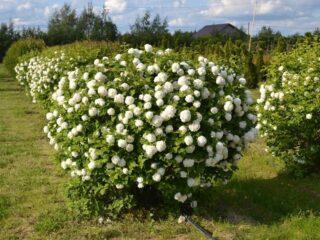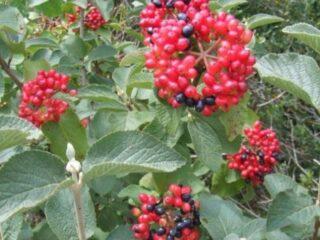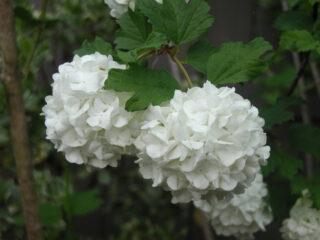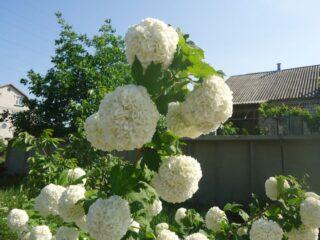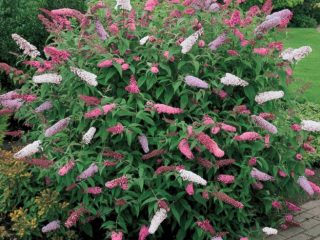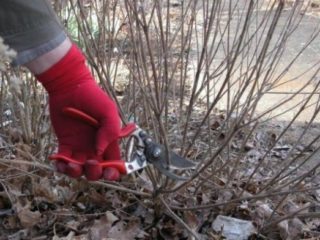Content
Propagating viburnum is not particularly difficult if you know what methods are best to use, when to carry out the procedure and how to care for the plants. Therefore, in order to avoid serious mistakes later, it is necessary to study all the features in advance. Only in this case can you grow new seedlings of this shrub without any problems.
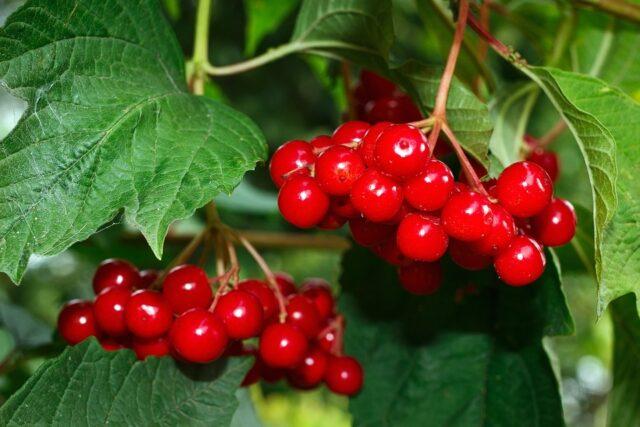
Vegetative methods are used to propagate viburnum
How does viburnum reproduce?
You can get new viburnum bushes in different ways. Each of them has certain characteristics, the observance of which allows one to obtain high-quality planting material.
The most common of them:
- seeds;
- layering;
- root shoots;
- dividing the bush.
The first method of propagation allows you to obtain new seedlings in large quantities, but it does not guarantee the preservation of the varietal qualities of the mother bush.The remaining methods produce a limited number of young seedlings, but they will be completely consistent with the original type of crop.
Is it possible to propagate viburnum from cuttings?
Red viburnum can also be propagated using cuttings. This procedure is best combined with pruning the bushes in order to obtain a sufficient amount of planting material. For some species, growing viburnum by cuttings may be the only method of propagation that will allow you to preserve the variety you like. But for it to be successful, it is necessary to study the specifics of its implementation.
How to propagate and grow viburnum from cuttings in spring and autumn
Propagation by cuttings allows you to obtain a sufficient amount of viburnum planting material that fully preserves the varietal qualities. Therefore, this is the method used by professionals.
Viburnum can be propagated by green and semi-lignified cuttings. The first method is used in spring, and the second in autumn. Each of them has features that you need to pay attention to in order for the procedure to be successful.
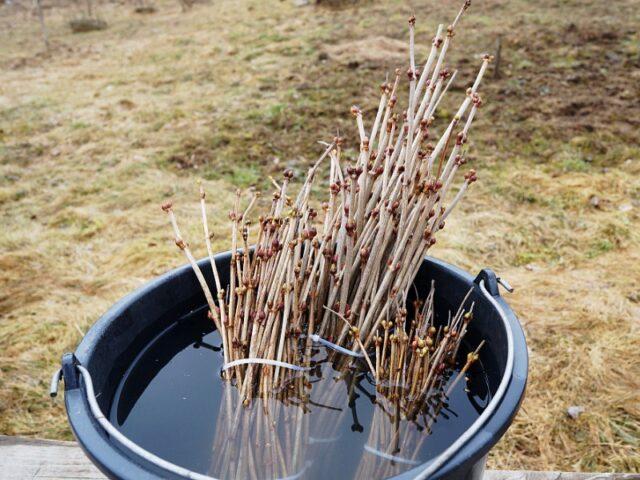
Semi-lignified cuttings need to be saturated with moisture for successful storage until spring
How to cut viburnum viburnum
Preparation of planting material in spring should be carried out in May. To do this, you should select young green shoots 10-15 cm long. It is recommended to cut them from the branches with a “heel”, since in this case they take root better.
When cutting in autumn, you need to choose semi-lignified one-year shoots. They can be identified by their lighter shade of bark. For propagation, use the middle parts of branches 10-12 cm long with two or three nodes.
How to root and plant cuttings
To plant green cuttings, you need to prepare a shaded place on the site. The bed should first be loosened and humus and sand should be added to the soil at the rate of 5 kg per square meter. m. When planting, the lower cut must be powdered with any root former. Place the cuttings at a distance of 5 cm from each other. Plant them in well-moistened soil and compact the soil surface at the base. For successful rooting, you need to build a mini-greenhouse on top.
Viburnum is not planted with cuttings for the winter. Seedlings harvested in the fall must be soaked in water for several hours. Then tie the planting material in a bundle and place it in a damp cloth, and wrap it on top with polyethylene with holes for ventilation. The resulting package should be stored until spring on the bottom shelf of the refrigerator.
At the end of February, cuttings for propagation should be planted in prepared containers filled with peat, turf and sand in equal quantities. The lower cut should be deepened by 2 cm. It is recommended to place the shoots at a distance of 4-5 cm. At the end of the procedure, cover the seedlings with a transparent film. At first, viburnum cuttings should be kept at a temperature of +27-30 degrees and maintain humidity at 90%, regularly spraying the seedlings.
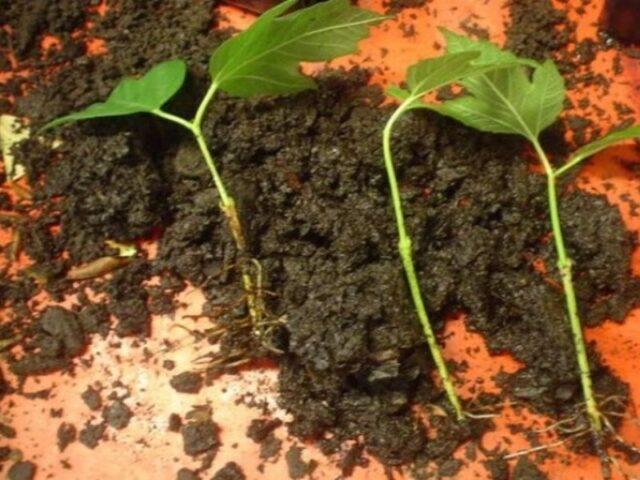
Viburnum cuttings take root in three to four weeks
Aftercare
Throughout the season, it is necessary to maintain optimal conditions for plant growth. They should be watered regularly when topsoil is added. It is also necessary to ventilate the plantings and remove accumulated condensation from the film.
When viburnum cuttings begin to grow, they should be adapted to external conditions.To do this, it is necessary to remove the cover for 2-3 hours in the first days, and with each subsequent time increase the interval by another half hour. After a week, the mini-greenhouse needs to be completely removed.
Young viburnum seedlings can be transplanted to a permanent place only next spring. They will begin to bear fruit at the age of five years.
Propagation of viburnum by seeds
The seed method of propagating viburnum is rarely used by gardeners, since the resulting seedlings do not retain varietal qualities.
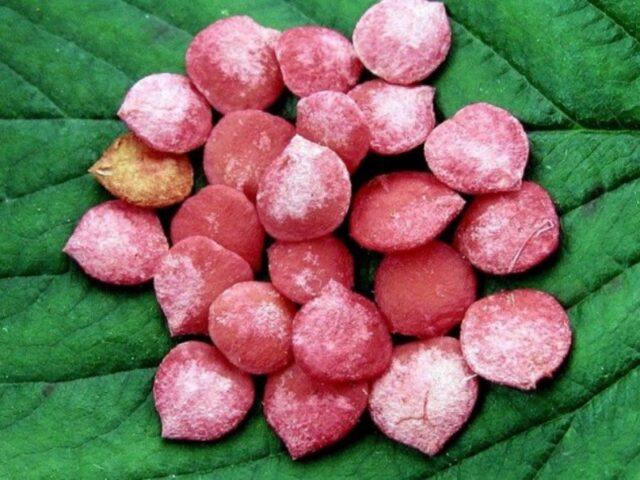
Viburnum seeds remain viable in spring for two years
There are two options for growing seedlings this way. In the first case, immediately after picking berries in the fall, you need to remove their pulp and remove the seeds. Then prepare a bed under the shade of bushes or trees, where the soil is constantly moderately moist. To do this, you need to dig up the area and add humus and sand 5 kg per square meter. m. After this, make furrows 3 cm deep and plant seeds in moist soil. When planted directly in open ground, they will undergo natural stratification in winter and germinate after 18 months.
To speed up the process of growing viburnum using the seed propagation method, it is necessary to carry out rapid stratification. To do this, place freshly collected and peeled viburnum seeds in a nylon stocking and place them in damp moss or sand. For the first two months they must be kept at a temperature of +18-23 degrees, and then for 30 days at +4 degrees.
After stratification is completed, the seeds must be planted in containers filled with a nutrient mixture of sand, peat and humus, without burying the subcotyledon in the soil.At the end of the procedure, moisten the substrate and keep it in a shaded place with a temperature of +20 degrees, covered with film. At the end of winter - at the beginning of spring, when sprouts begin to appear, the container should be moved to the windowsill and the mode should be lowered to +18 degrees.
Over the next year, they need to be kept at home, and planted in open ground only next spring.
Reproduction by layering
The red viburnum bush can be propagated by horizontal and vertical layering. In the first case, in the fall, it is necessary to initially loosen the soil under the plant to a depth of 5-7 cm. And with the arrival of spring, bend the young side shoots to the soil, deepen them completely by 5 cm and secure them with staples. Subsequently, when the young shoots grow to 20 cm, they need to be earthed up. Repeat the procedure several times a season, which will allow the layering to build up a powerful root system. With the arrival of autumn, the seedlings can be detached from the mother bush and planted in a permanent place.
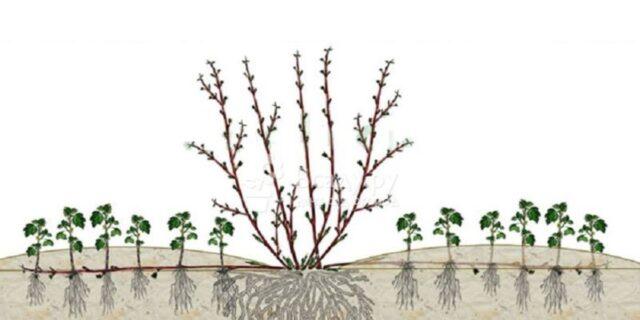
Bushes grown from cuttings have a 100% survival rate
The second method of propagation is that in the fall it is necessary to trim the lower branches of the bush so that no more than two to four buds remain on them. And then hill up the plant with fertile soil to a height of 15-20 cm. With the arrival of spring, sprouts will appear from the left buds. When they reach a height of 10-15 cm, you need to hill them by 4-5 cm, repeat the procedure several times a season. In the fall, separate the mature seedlings from the mother bush and transplant them to a permanent place.
Reproduction by root shoots
You can get new red viburnum seedlings from the root shoots that form at the base of the bush. To do this, in early spring or early autumn, you need to detach well-established specimens with root shoots. After the procedure, they can be immediately transplanted to the prepared place and watered.
Reproduction by dividing the bush
This propagation method is used for shrubs older than six to eight years. It is necessary to dig up red viburnum in the fall and divide it into several parts. Each of them should have three to four shoots and well-developed root processes. At the end of the procedure, open wounds on the “delenki” should be sprinkled with wood ash so that they do not become infected. And then plant the seedlings in a permanent place.
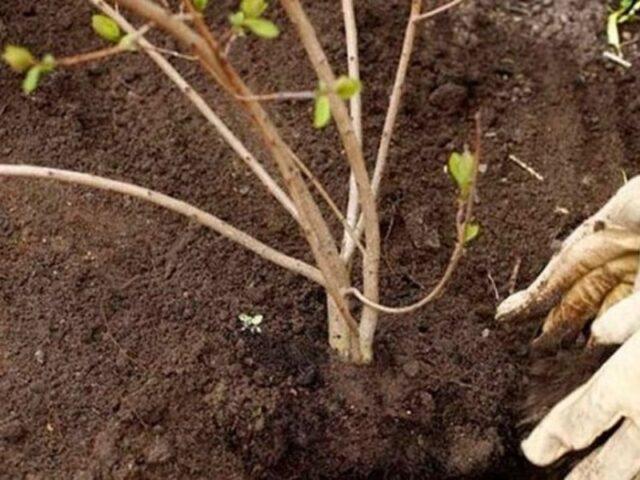
Dividing the bush allows you to rejuvenate the plant
Conclusion
Propagation of viburnum can be carried out in different ways, and each of them makes it possible to obtain a sufficient number of young plants if you follow all the specified instructions. Therefore, if desired, even a novice gardener can grow new bushes of the crop variety he likes without much difficulty.
